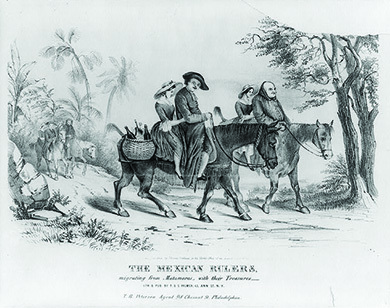| << Chapter < Page | Chapter >> Page > |
The small but vocal antislavery faction decried the decision to go to war, arguing that Polk had deliberately provoked hostilities so the United States could annex more slave territory. Illinois representative Abraham Lincoln and other members of Congress issued the “Spot Resolutions” in which they demanded to know the precise spot on U.S. soil where American blood had been spilled. Many Whigs also denounced the war. Democrats, however, supported Polk’s decision, and volunteers for the army came forward in droves from every part of the country except New England, the seat of abolitionist activity. Enthusiasm for the war was aided by the widely held belief that Mexico was a weak, impoverished country and that the Mexican people, perceived as ignorant, lazy, and controlled by a corrupt Roman Catholic clergy, would be easy to defeat. ( [link] ).

U.S. military strategy had three main objectives: 1) Take control of northern Mexico, including New Mexico; 2) seize California; and 3) capture Mexico City. General Zachary Taylor and his Army of the Center were assigned to accomplish the first goal, and with superior weapons they soon captured the Mexican city of Monterrey. Taylor quickly became a hero in the eyes of the American people, and Polk appointed him commander of all U.S. forces.
General Stephen Watts Kearny, commander of the Army of the West, accepted the surrender of Santa Fe, New Mexico, and moved on to take control of California, leaving Colonel Sterling Price in command. Despite Kearny’s assurances that New Mexicans need not fear for their lives or their property, and in fact the region’s residents rose in revolt in January 1847 in an effort to drive the Americans away. Although Price managed to put an end to the rebellion, tensions remained high.
Kearny, meanwhile, arrived in California to find it already in American hands through the joint efforts of California settlers, U.S. naval commander John D. Sloat, and John C. Fremont, a former army captain and son-in-law of Missouri senator Thomas Benton. Sloat, at anchor off the coast of Mazatlan, learned that war had begun and quickly set sail for California. He seized the town of Monterey in July 1846, less than a month after a group of American settlers led by William B. Ide had taken control of Sonoma and declared California a republic. A week after the fall of Monterey, the navy took San Francisco with no resistance. Although some Californios staged a short-lived rebellion in September 1846, many others submitted to the U.S. takeover. Thus Kearny had little to do other than take command of California as its governor.
Leading the Army of the South was General Winfield Scott. Both Taylor and Scott were potential competitors for the presidency, and believing—correctly—that whoever seized Mexico City would become a hero, Polk assigned Scott the campaign to avoid elevating the more popular Taylor, who was affectionately known as “Old Rough and Ready.”

Notification Switch
Would you like to follow the 'U.s. history' conversation and receive update notifications?